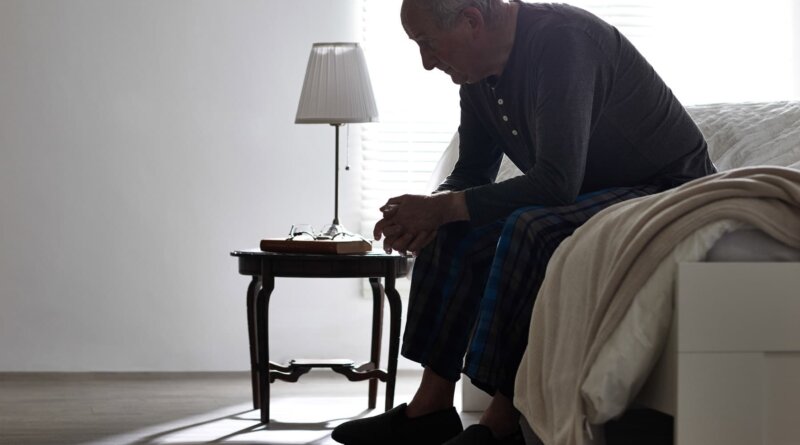Prostate Cancer’s ‘Elephant in the Room’
Nov. 2, 2022 – Mark Lichty, 73, said it took a decade for him to overcome the anxiety, fear of death, and uncertainty about the future after he was diagnosed with low-grade prostate cancer in 2005.
Lichty, of East Stroudsburg, PA, channeled some of this anxious energy into launching Active Surveillance Patients International (ASPI), which he co-founded in 2017 to help men with low-risk prostate tumors to cope with the worry that their condition may evolve from benign to life-threatening.
Many men have taken to calling this state of limbo “anxious surveillance” – a baseline level of concern that gets worse while they await the results of periodic blood tests that, depending on the results, can signal the need for surgery or radiation therapy to remove a tumor that’s become more aggressive.
Ironically, Lichty says, those same tests – which look at levels of a protein called prostate-specific antigen, or PSA – led to an “epidemic of overdiagnosis” of prostate cancer in the 1990s. That in turn led to overtreatment that resulted in erectile dysfunction, incontinence, and other problems for many patients – and now, he says, “the epidemic of anxious surveillance that can result in unnecessary distress in these patients and even in more overtreatment.”
Mental distress has been called the “elephant in the room” for patients with prostate cancer that doesn’t require treatment right away. For years, these concerns were largely ignored, according to advocates and health professionals.
But lately, the prostate cancer community has begun focusing on mental health for this group. One factor has been the stress caused by COVID-19.
“The mental health crisis from the COVID-19 pandemic has brought this issue into focus in prostate cancer,” says Rick Davis, of Tucson, AZ, who was diagnosed with the disease in 2007.
Davis is the founder of AnCan Foundation, which runs support groups for people with prostate cancer – the most diagnosed cancer in men. According to the American Cancer Society, 268,000 men in the United States will learn they have prostate cancer this year, up about 10,000 from 2021. An estimated 1 in 8 men will be diagnosed with the disease in their lifetime, the group says.
For Davis, those figures point to an overwhelming need for more services like those his foundation provides.
“We have attempted to do some programming, but we haven’t taken the bull by the horns,” he says. “We really saw that it was the elephant in the room, and we needed to identify it and do something about it.”
AnCan and ASPI started one of the first virtual support groups for patients with low- and favorable intermediate-risk prostate cancer in 2019. A 2021 survey of 168 people in the support group found that 30% reported symptoms of anxiety.
That’s in line with a 2014 study by researchers in the United Kingdom who found that among nearly 4,500 patients with prostate cancer across the treatment spectrum, 17% of men reported depression, and 27% reported anxiety, before they were treated for the disease.
The figure for anxiety is roughly twice that in the general population of men in the United States, says John Oliffe, PhD, founder, and lead investigator of the University of British Columbia’s Men’s Health Research program. Untreated anxiety can lead to other mental health problems, including depression and suicidal thoughts and behavior, he says.
“Anxiety has often been overlooked. The true breadth and gravity of men’s anxiety is unknown, which is particularly concerning, given undetected and untreated anxiety predicts future deleterious mental health outcomes,” Oliffe says.
In September, the Prostate Cancer Foundation, the largest private funder of research on prostate cancer, held a patient-oriented program. On Nov. 17, the Prostate Cancer Impact Alliance is holding a webinar on emotional wellness.
Scott Tagawa, MD, medical director of the Genitourinary Oncology Research Program at Weill Cornell Health in New York City, and a spokesman for the American Society of Clinical Oncology, says, “the world is recognizing mental health issues in cancer more than it did. It was starting to happen before the COVID-19 pandemic, but it was brought up by some issues with the pandemic.”
Tagawa says the total number of men in mental distress may be understated. “Men tend to be less communicative and verbal,” he says. “They hide things.”
Jim C. Hu, MD, a professor of urology at Weill Cornell, said mental health issues are coming into play now because of “a greater emphasis on the whole patient. This goes with patient-centered care. There is a focus on mental health issues in terms of patient care, particularly as it comes to cancer patients.”
Corey Lyon, DO, vice chair for clinical affairs in the Department of Family Medicine at the University of Colorado School of Medicine, says primary care doctors are playing a bigger role in providing psychiatric care and can offer emotional support for these patients as part of an emphasis on “whole-person care.”
“But a lot of clinics may not necessarily be doing this screening because they don’t know what to do with the results,” says Lyon, who’s chair of the American Academy of Family Physicians’ guidelines committee. “They don’t have the tools or resources if a patient has a high level of distress or higher symptoms of anxiety or depression. If they don’t know what to do with the results, they tend not to screen.”
Successful Approaches
A few leading clinics, such as Memorial Sloan Kettering Cancer Center in New York City, routinely screen prostate cancer patients for mental health issues.
Andrew J. Roth, MD, a psychiatrist who has devoted his career at the center to mental health issues and patients with prostate cancer and their families, helped develop scales to measure distress in prostate cancer patients, like the Distress Thermometer in 1998. Roth also helped develop the Memorial Anxiety Scale for Prostate Cancer and is working on a scale to identify depression in older cancer patients.
“Screening for distress tries to identify signals that someone is having difficulty dealing with cancer that might interfere with making treatment decisions, managing treatment, improving quality of life, or that a particular patient does not have enough social support,” Roth says. “Then there is the opportunity to get them the help they need. If we do not ask, we may not find out, and won’t be able to help these men cope better with their prostate cancer and their lives in a timely manner.”
But not everyone agrees with the value of such tools. Darryl Mitteldorf, a licensed clinical social worker and founder of the New York City-based Malecare support group for prostate cancer, is among the skeptics.
“The [anxiety] scale that Roth came up with and a lot of people use is great for clinical trials,” he says. “But in a practical day-to-day sense, it’s somewhat irrelevant to helping people with prostate cancer get on with their lives and being as happy and hopeful as they possibly can.”
Through the Prostate Cancer Impact Alliance, an advocacy group within the American Urological Association, Davis in September began promoting an effort to screen for mental distress. He says the vision is for medical specialties involved in the care of patients with prostate cancer – urologists, radiation oncologists, genitourinary oncologists, primary care doctors, and even psychiatrists – to develop guidelines as a group.
“They all need to come together, and the idea is to monitor, identify, and navigate people to get treatment to deal with these mental health issues and maybe even crises,” Davis says. “Right now, we’re not even identifying these people.




